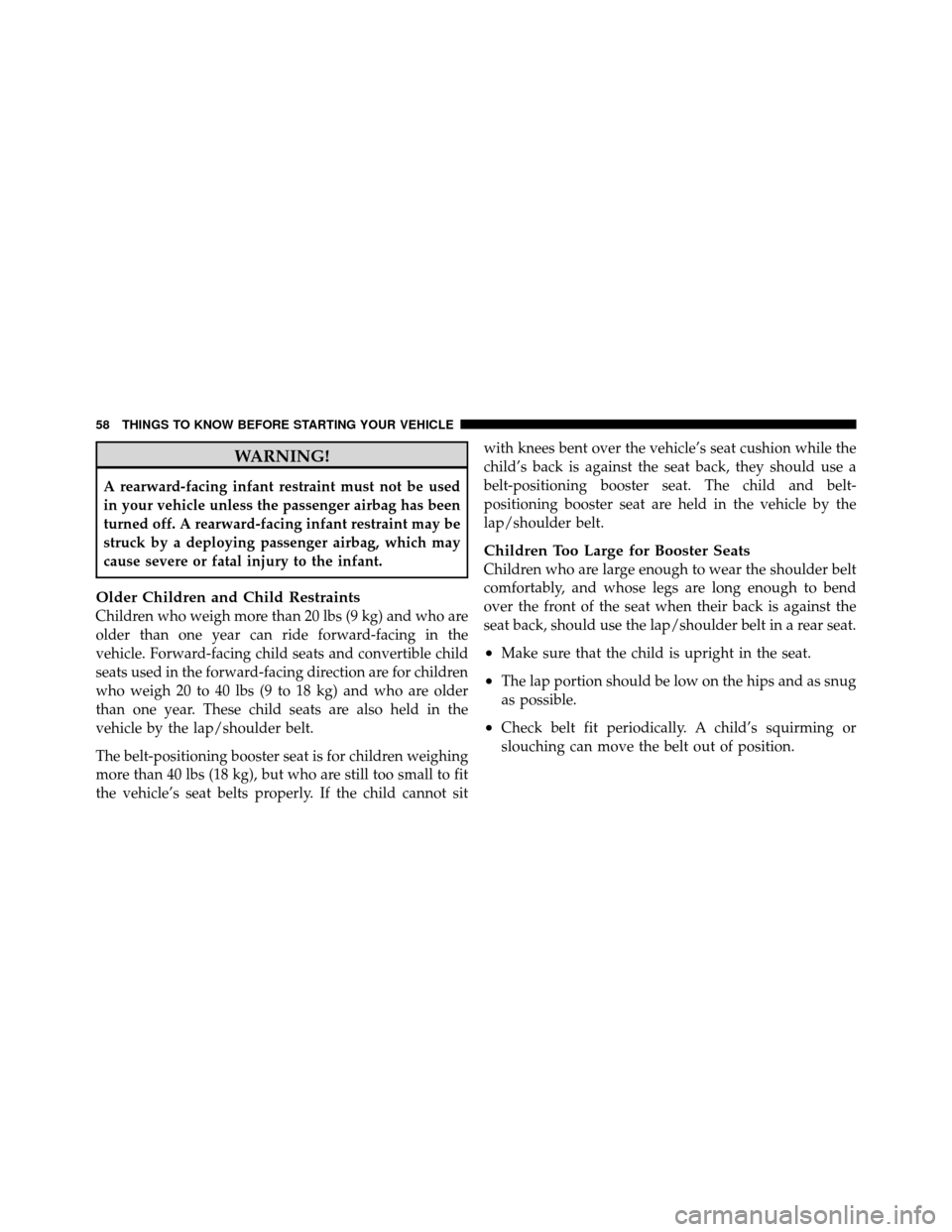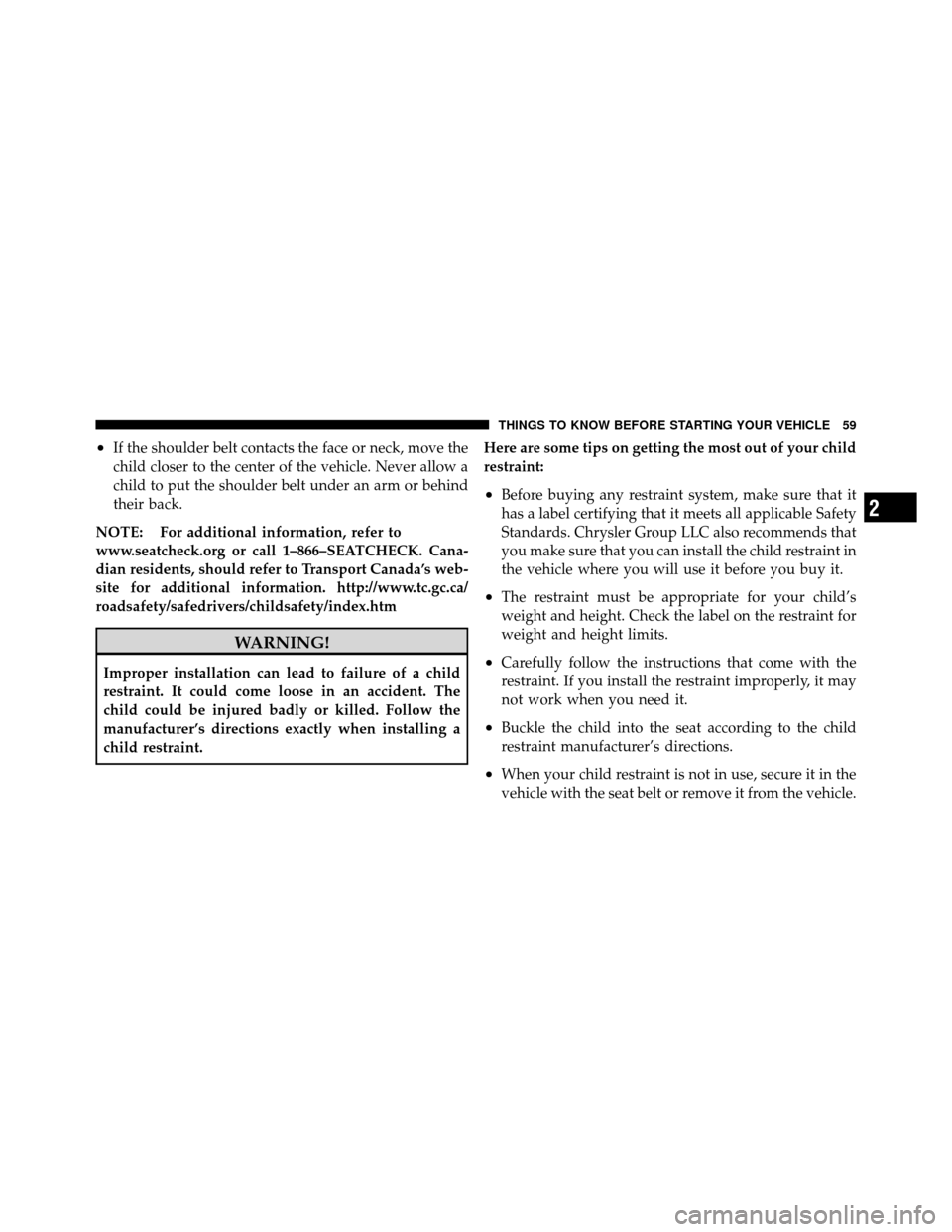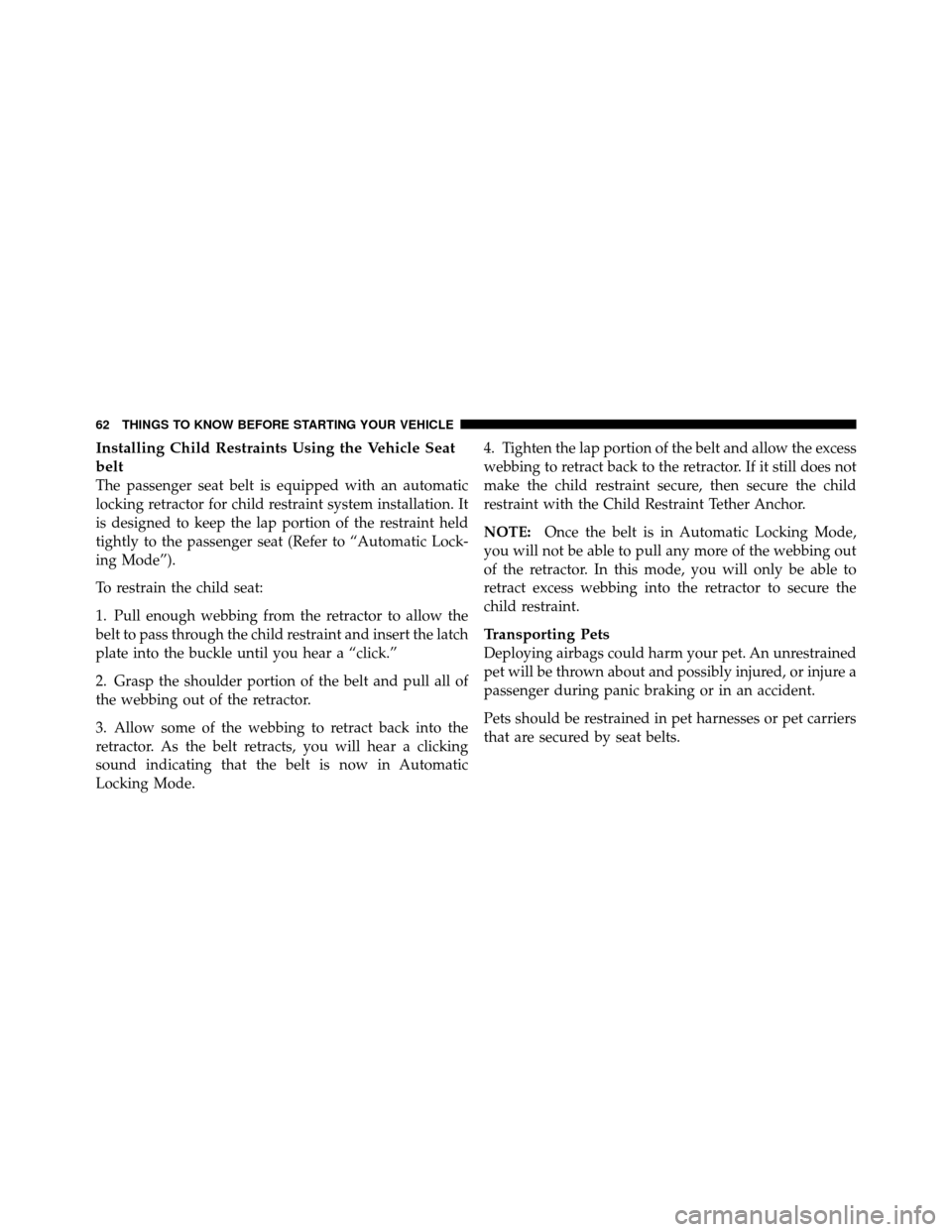Page 62 of 315

WARNING!
A rearward-facing infant restraint must not be used
in your vehicle unless the passenger airbag has been
turned off. A rearward-facing infant restraint may be
struck by a deploying passenger airbag, which may
cause severe or fatal injury to the infant.
Older Children and Child Restraints
Children who weigh more than 20 lbs (9 kg) and who are
older than one year can ride forward-facing in the
vehicle. Forward-facing child seats and convertible child
seats used in the forward-facing direction are for children
who weigh 20 to 40 lbs (9 to 18 kg) and who are older
than one year. These child seats are also held in the
vehicle by the lap/shoulder belt.
The belt-positioning booster seat is for children weighing
more than 40 lbs (18 kg), but who are still too small to fit
the vehicle’s seat belts properly. If the child cannot sitwith knees bent over the vehicle’s seat cushion while the
child’s back is against the seat back, they should use a
belt-positioning booster seat. The child and belt-
positioning booster seat are held in the vehicle by the
lap/shoulder belt.
Children Too Large for Booster Seats
Children who are large enough to wear the shoulder belt
comfortably, and whose legs are long enough to bend
over the front of the seat when their back is against the
seat back, should use the lap/shoulder belt in a rear seat.
•Make sure that the child is upright in the seat.
•The lap portion should be low on the hips and as snug
as possible.
•Check belt fit periodically. A child’s squirming or
slouching can move the belt out of position.
58 THINGS TO KNOW BEFORE STARTING YOUR VEHICLE
Page 63 of 315

•If the shoulder belt contacts the face or neck, move the
child closer to the center of the vehicle. Never allow a
child to put the shoulder belt under an arm or behind
their back.
NOTE: For additional information, refer to
www.seatcheck.org or call 1–866–SEATCHECK. Cana-
dian residents, should refer to Transport Canada’s web-
site for additional information. http://www.tc.gc.ca/
roadsafety/safedrivers/childsafety/index.htm
WARNING!
Improper installation can lead to failure of a child
restraint. It could come loose in an accident. The
child could be injured badly or killed. Follow the
manufacturer’s directions exactly when installing a
child restraint. Here are some tips on getting the most out of your child
restraint:
•Before buying any restraint system, make sure that it
has a label certifying that it meets all applicable Safety
Standards. Chrysler Group LLC also recommends that
you make sure that you can install the child restraint in
the vehicle where you will use it before you buy it.
•The restraint must be appropriate for your child’s
weight and height. Check the label on the restraint for
weight and height limits.
•Carefully follow the instructions that come with the
restraint. If you install the restraint improperly, it may
not work when you need it.
•Buckle the child into the seat according to the child
restraint manufacturer’s directions.
•When your child restraint is not in use, secure it in the
vehicle with the seat belt or remove it from the vehicle.
2
THINGS TO KNOW BEFORE STARTING YOUR VEHICLE 59
Page 64 of 315

Do not leave it loose in the vehicle. In a sudden stop or
accident, it could strike the occupants or seat backs
and cause serious personal injury.
Child Restraint Tether Anchor
Child restraints having tether straps and hooks
for connection to tether anchors have been
available for some time. In fact, many child
restraint manufacturers will provide add-on
tether-strap kits for some of their older products. There is
a tether strap anchor located behind the child tether
access cover behind the passenger seat.
To attach a child restraint tether strap:
1. Move the seat forward.
2. Move the seatback to its full forward position.
3. Remove the child tether access cover by prying either
side with a screwdriver or similar tool, as shown. NOTE:
While the child tether is in use, keep the access
cover in a safe place so that it can be replaced after use of
the child tether.
4. Pass the child restraint tether hook through either
opening in the seatback underneath the head restraint.
Child Tether Access Cover
60 THINGS TO KNOW BEFORE STARTING YOUR VEHICLE
Page 65 of 315
5. Attach the tether hook to the anchor loop.
6. Move the seat to its farthest rearward position. Apply
body pressure to the seat to be sure the seat adjusters
have latched.7. Return the seatback to an upright position.
8. Install the child restraint according to the manufactur-
er’s directions.
9. Remove slack from the tether strap according to the
child restraint manufacturer’s directions.
WARNING!
An incorrectly anchored tether strap could lead to
increased head motion and possible injury to the
child. Use only the anchor position directly behind
the child seat to secure a child restraint top tether
strap.
Tether Hook
2
THINGS TO KNOW BEFORE STARTING YOUR VEHICLE 61
Page 66 of 315

Installing Child Restraints Using the Vehicle Seat
belt
The passenger seat belt is equipped with an automatic
locking retractor for child restraint system installation. It
is designed to keep the lap portion of the restraint held
tightly to the passenger seat (Refer to “Automatic Lock-
ing Mode”).
To restrain the child seat:
1. Pull enough webbing from the retractor to allow the
belt to pass through the child restraint and insert the latch
plate into the buckle until you hear a “click.”
2. Grasp the shoulder portion of the belt and pull all of
the webbing out of the retractor.
3. Allow some of the webbing to retract back into the
retractor. As the belt retracts, you will hear a clicking
sound indicating that the belt is now in Automatic
Locking Mode.4. Tighten the lap portion of the belt and allow the excess
webbing to retract back to the retractor. If it still does not
make the child restraint secure, then secure the child
restraint with the Child Restraint Tether Anchor.
NOTE:
Once the belt is in Automatic Locking Mode,
you will not be able to pull any more of the webbing out
of the retractor. In this mode, you will only be able to
retract excess webbing into the retractor to secure the
child restraint.
Transporting Pets
Deploying airbags could harm your pet. An unrestrained
pet will be thrown about and possibly injured, or injure a
passenger during panic braking or in an accident.
Pets should be restrained in pet harnesses or pet carriers
that are secured by seat belts.
62 THINGS TO KNOW BEFORE STARTING YOUR VEHICLE
Page 68 of 315

SAFETY TIPS
Transporting Passengers
NEVER TRANSPORT PASSENGERS IN THE CARGO
AREA.
WARNING!
•Do not leave children or animals inside parked
vehicles in hot weather. Interior heat build-up may
cause serious injury or death.
•It is extremely dangerous to ride in a cargo area,
inside or outside of a vehicle. In a collision, people
riding in these areas are more likely to be seri-
ously injured or killed.
•Do not allow people to ride in any area of your
vehicle that is not equipped with seats and seat
belts.
•Be sure everyone in your vehicle is in a seat and
using a seat belt properly.
Exhaust Gas
WARNING!
Exhaust gases can injure or kill. They contain carbon
monoxide (CO), which is colorless and odorless.
Breathing it can make you unconscious and can
eventually poison you. To avoid breathing (CO)
follow these safety tips:
Do not run the engine in a closed garage or in confined
areas any longer than needed to move your vehicle in or
out of the area.
If it is necessary to sit in a parked vehicle with the engine
running, adjust your heating or cooling controls to force
outside air into the vehicle. Set the blower at high speed.
64 THINGS TO KNOW BEFORE STARTING YOUR VEHICLE
Page 148 of 315

STARTING PROCEDURES
Before starting your vehicle, adjust your seat, adjust the
inside and outside mirrors, fasten your seat belt, and if
present, instruct any other occupant to buckle their seat
belt.
WARNING!
Never leave children alone in a vehicle. Leaving
children in a vehicle unattended is dangerous for a
number of reasons. A child or others could be injured
seriously or fatally. Do not leave the keys in the
ignition. A child could operate power windows,
other controls, or move the vehicle.
CAUTION!
Long periods of engine idling, especially at high
engine speeds, can cause excessive exhaust tempera-
tures, which can damage your vehicle. Do not leave
your vehicle unattended with the engine running.
Normal Starting
CAUTION!
The engine in your vehicle is designed for operation
down to 0°F (-18°C). Starting the engine below 0°F
(-18°C) creates a potential for scuffing or seizing of
internal components in this very high performance
engine. To prevent engine damage, do not start the
engine at temperatures below 0°F (-18°C).
144 STARTING AND OPERATING
Page 301 of 315

Jump Starting......................... 202
Keyless Transmitter Replacement (RKE) ....... 22
Location .......................... 202,217
Saving Feature (Protection) ............... 219
Storing Vehicle ........................ 219
Belts, Seat .......................... 32,34,65
Body Mechanism Lubrication ............... 223
Boot, Convertible Top ................... 75,79
B-Pillar Location ........................ 167
Brake, Parking .......................... 155
Brake System ........................ 157,232
Anti-Lock (ABS) .................... 157,158
Fluid Check ....................... 233,262
Master Cylinder ....................... 233
Warning Light ........................ 112
Break-In Recommendations, New Vehicle .....63,157
Bulb Replacement ....................... 251
Bulbs, Light .......................... 67,250Capacities, Antifreeze (Engine Coolant)
........ 260
Capacities, Fluid ........................ 260
Caps, Filler Fuel ............................... 185
Power Steering ........................ 154
Radiator (Coolant Pressure) ............... 230
Car Washes ............................ 238
Carbon Monoxide Warning ...............64,185
CD (Compact Disc) Changer ................ 125
CD (Compact Disc) Player ............... 119,123
Cellular Phone .......................... 134
Charging System Light .................... 118
Chart, Tire Sizing ........................ 163
Check Engine Light
(Malfunction Indicator Light) ............... 211
Checking Your Vehicle For Safety ............. 64
Checks, Safety ........................... 64
Child Restraint ...................... 56,58,62
Child Restraint Tether Anchors ............... 60
10
INDEX 297